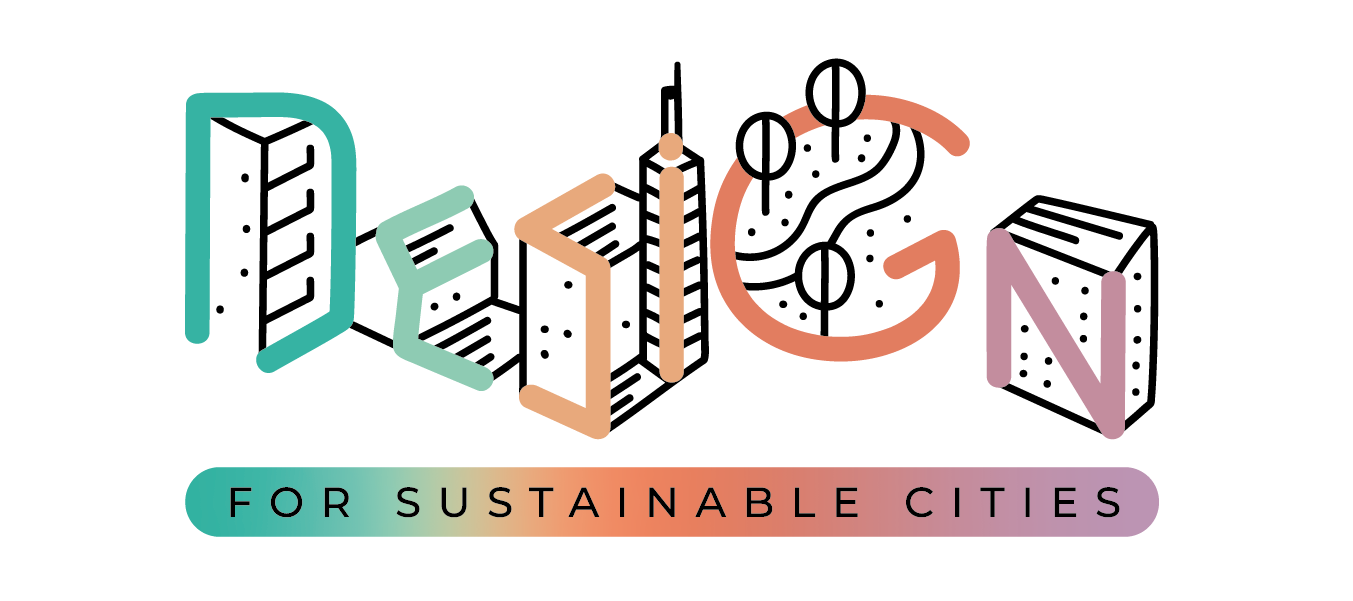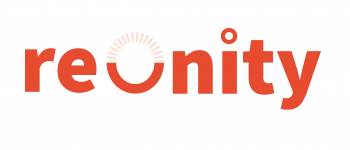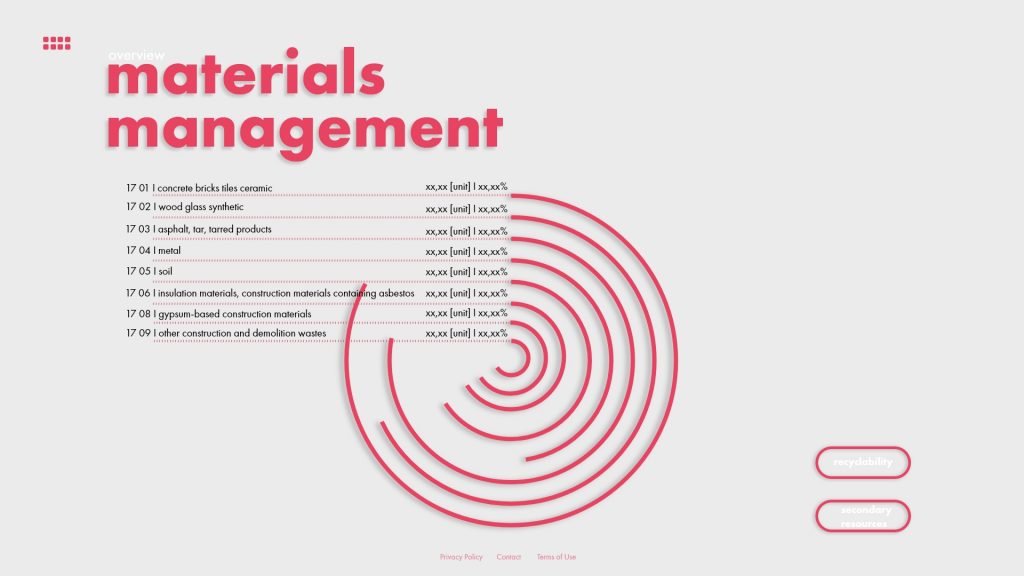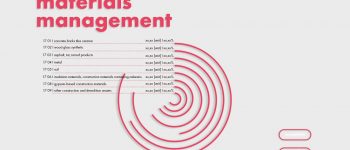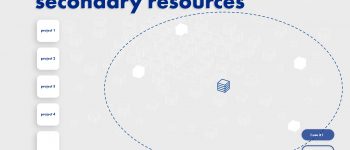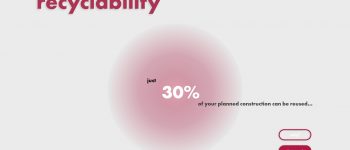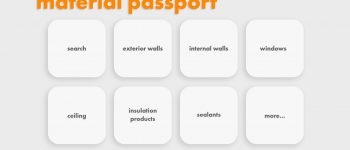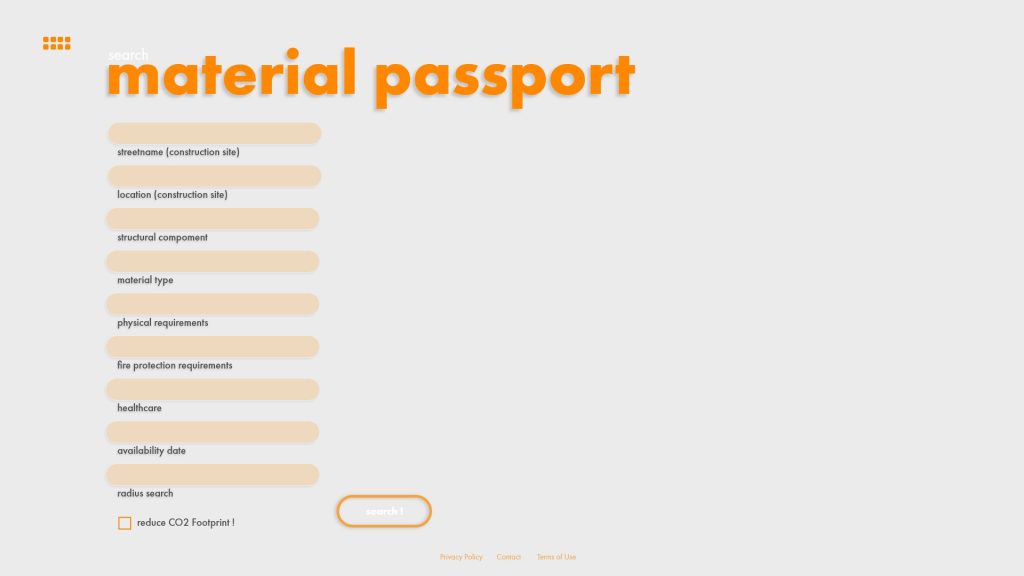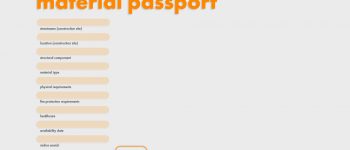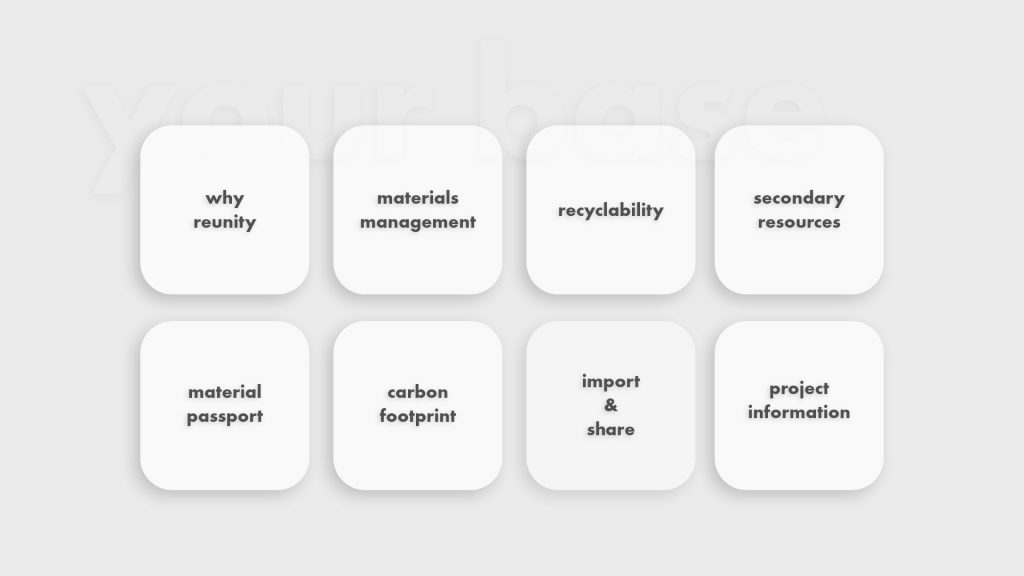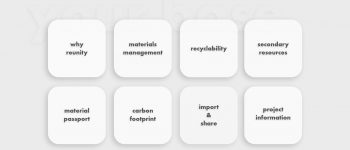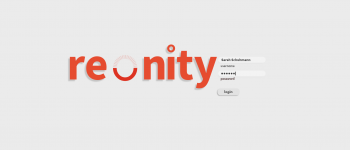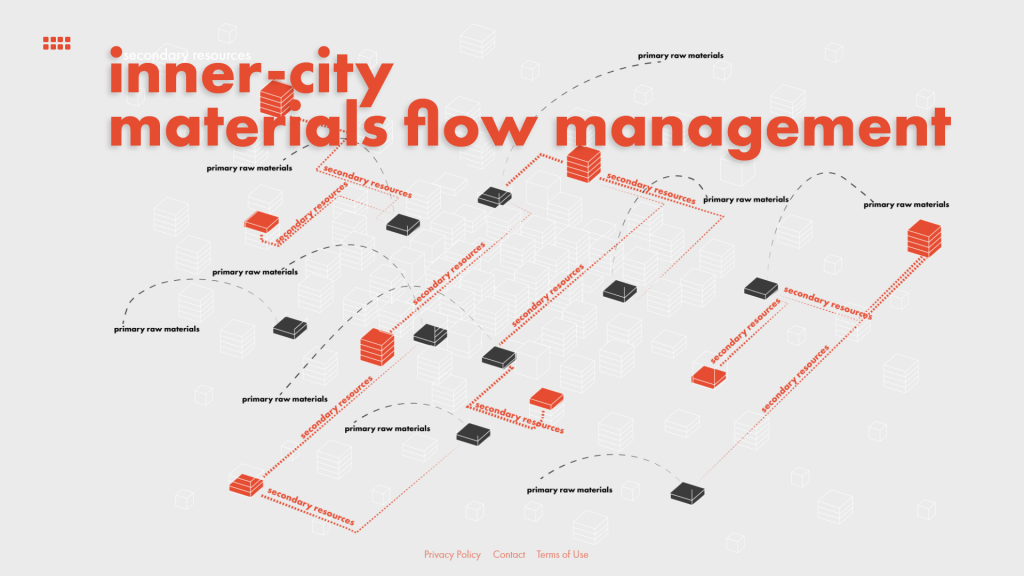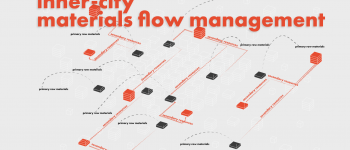If you look at modern cities the need for sustainability, connection of processes is evident. The main issue is an increasing unused anthropogenic deposit of resources in cities and at the same time an increasing global sacarcity of resources. Every day tons of our dwindling resources are used in our cities without considering a deconstruction concept to reuse building materials in a forseeable time. This leads to an ignorance surrounding useful resources and its quantities and qualities. This reinforces the lack of secondary materials trade transparency which labels recyclates as an unrelieable and no forseeable resource. The building industry is a significant part of our carbon footprint but the clear way to change and its methods are intransparent and inaccessible for the general public. Therefore it is still a cumbersome and uneconomic. The circular economy in the building industry is still in its infancy and its translation in design processes isn’t clear to everyone.
If you look at modern cities the need for sustainability and the transparent connection of processes is evident. The main issue is an increasing unused anthropogenic deposit of resources in cities and at the same time an increasing global sacarcity of resources. Every day tons of our dwindling resources are used in our cities without a controlled material flow management system. This leads to an ignorance surrounding useful resources and reinforces the lack of secondary materials trade transparency which labels recyclates as an unrelieable and no forseeable resource. The circular economy in the building industry is still in its infancy and its translation in design processes not clear to everyone. The aim is to provide a digital software ecosystem to decrease the lacks of transparency and to visualize and support the dependencies of sustainable management within the construction-project. Starting with Information design previously invisible information becomes transparent and tangible through appropriate data visualizations. This helps to minimize the inherent complexity of resource management and construction-projects.
A sustainable architecture thrives from highest levels of transparency and flexibility. Decisions should be made aided by the use of Smart Data, by data visualizations and useful automated procedures.
All the data from the IFC-Data-Files are collected and analyzed, moreover it is validated, giving a context and a use. So Big Data is transformed to Smart Data. This is the foundation of the software ecosystem. Data calculations are made by the software. Starting with Information Design previously invisible information becomes transparent and tangible through appropriate data visualizations. This helps to minimize the inherent complexity of resource management and construction-projects. So the user is (even without previous training or a deep dive) able to understand the entire system and the digital twin of the planned construction-project (transparency, user-friendly). Moreover the user interface is reduced to the essential to ensure transparency, quality and a guided user experience.
The aim is that the core values of this software ecosystem can be used as a compass across the whole industry.
The software ecosystem „reunity” includes 1) materials management 2) inner-city materials flow management 3) recyclability 4) carbon footprint 5) material passport. „reunity“ lays the foundation for a new value creation logic in the architecture and inner-city materials flow management.The data-based approach helps to preserve, obtain and improve transparency and quality.
Material management
After importing the IFC-file into the software, the user has the possibility to get information about the material management of the planned building. For the information presentation “reunity” does not take over the categorization according to cost categories (here: DIN 276 Germany) but takes over the systematization of the building materials according to the European waste-listing. This list is the basis for the material management of the German recycling companies. The classification can be adapted to the systematization of raw materials of each country. With this new categorization, the interface between planners and recycling companies is established. After the completion of the construction the digital twin contains all relevant information (quantity data, material data, time of use, type of construction), the project manager can upload the model to the “reunity”-community. The recycling companies directly receive all relevant information and can plan, process and handle future material flows more accurately. The more information is integrated into the software, the larger are the material flows. An inner-city materials flow management system is created.
Inner-city materials flow management
Once approved, “reunity” updates the digital inner-city resource inventory in the community and recyclers and (future-) planners receive detailed information about secondary raw materials that will be released in the future. The current urban building inventory can also be subsequently fed into the digital network. The intention is to have knowledge about the used materials in every single real estate in the cities. With every shared digital project and its information, the knowledge about used raw materials grows and enables the increasing success of using the city as a controlled urban mine.
Secondary resources
With the help of a functioning urban mine, the success of secondary raw material management is growing.
While construction companies and raw material producers can make reliable information about quantity, quality and delivery time, recycled materials tend to occur spontaneously in quantities that cannot be clearly calculated. “reunity” offers the possibility to use secondary resources as well as plannable and reliable building materials.
The user sees the visualization of the percentage of secondary raw materials in the digital twin and in addition he receives at the same time specific optimization suggestions calculated by “reunity”. Before the software communicates the suggestions, it has searched for applicable secondary raw materials in the “reunity” community. Since all community members have shared their data, „reunity“ can compare the detailed demand with the inventory. The program constantly pursues the goal of the lowest CO2 emission, so the search begins close to the project site to keep the transportation value low.
In addition, the user can also actively perform a search with the required information (structural component, material type, physical requirement, fire protection requirements, availability date and more). If the search results are satisfactory, “reunity” establishes a contact with the person in charge of the searched project. In case of serious need, the planner can reserve the resources for a certain period of time for a clarification requirement. From that moment, the availability of the building material is blocked in the “community” for a certain period of time. When secondary raw materials are taken over and purchased, there is also a corresponding change in the resource inventory in the software.
Recyclability
A prerequisite for successful secondary raw materials trading is a high degree of recyclability of the materials. As researches have shown, material recycling as well as product recycling is essential. For successful product recycling, selective deconstruction with the preservation of unmixed and undamaged products is fundamental. Selective deconstruction can only be successful through reversible design. To support this, “reunity” checks the planned constructions of the digital building for reversible and irreversible joints of the components. The user gets shown own planned construction details with specific possibilities for optimization in the digital twin at the push of a button. To optimize material recycling, “reunity” increases the recycling degree by comparing planned raw materials with the raw materials contained in the material database. Here, homogeneity is the goal as well as the necessary connections of the materials in the building bodies themselves. Only if necessary properties are not minimized, “reunity” shows spezific optimization suggestions from the material database.
Material passport
The material database gives the user easy access to all sustainable materials with or without quality seals, such as „cradle to cradle“. The materials are categorized by components (exterior walls, internal wall, ceiling, insulation products, sealants, and more). Both primary and secondary raw materials are offered. The secondary raw materials are automatically taken from the „reunity“-community. Furthermore, companies are given the opportunity to place their building materials directly with “reunity”. Since the digital ecosystem strives for a high degree of sustainability and high quality in all construction projects, the companies must comply with given requirements (e.g. healthcare) and guarantee the sustainability aspects.
When selecting a product, the user is automatically shown the optimization potential of the carbon footprint and sustainable aspects of his planned construction he can achieve with this suggest material. At the same time, “reunity” checks the material from the database against the planned product and shows all differences, especially physical properties and joining variations.
If the user is convinced by the proposed product, he will receive a direct overview of the required quantity and associated costs at the push of the button.
Carbon footprint
Throughout the planning process, „reunity“ constantly calculates the carbon footprint of the construction project and visualizes it to the user. The digital ecosystem constantly pursues the goal of keeping the carbon footprint as low as possible, but without compromising quality. The different possibilities to minimize it are automatically and constantly offered to the user during the whole planning process.
„reunity“ is the digital software ecosystem to decrease the lack of transparency and to visualize and support the dependencies of sustainable management within the construction-project.
Course of action
In addition to the research already carried out, iterative development processes are proposed in order to refine the core aspects from the different perspectives with the help of experts. However, I point out that not only experts should be involved in the development processes, but also non-professional users. During the entire process, I recommend conducting usability tests and user workshops at certain intervals, accompanied by Design Thinking workshops.
The first step is to assemble a team and hold initial discussion rounds with experts from the fields of 1) materials management 2) recyclability 3) carbon footprint 4) material passport 5) software development 6) digital design. Furthermore, a cooperation with building material producers, stakeholders from the real estate industry but also governmental support can be considered.
The software is the solution for redefining the unreliable secondary resource to a forseeable and plannable construction material. The basis for a reliable materials management within cities is created.
A building materials management is required to reach an inner-city materials management. The principle is to give knowledge about the planned materials and to raise awareness about its secondary use. The software integrates the knowledge about the materials management in the design process instead of thinking about it afterwards. But the materials are not categorized as cost categories, assuming the recycling industrie`s thinking its management system is used. As soon as a digital twin is shared the recycling companies receive reliable specific information they can plan with.
The success of recycle management depends on recyclability of every single construction. The software identifies the potential and recommends specific ways through construction or material use to optimize its recycle-intensity. The user gets free access to the material database filled with primary and secondary raw sustainable products. Further more the software measures the construction`s CO2-production in the background and compares continuously the user`s planned materials with the database aiming to minimize the CO2-footprint without any quality loss or necessary conditions.
